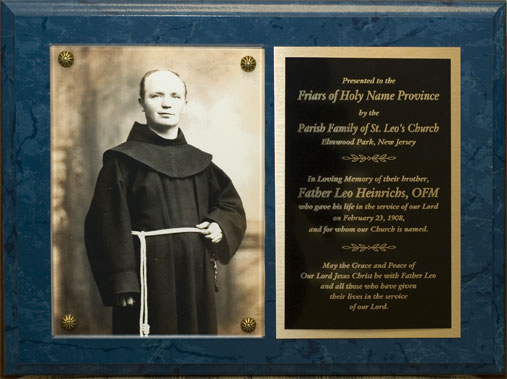
Servant of God Leo Heinrichs was a Franciscan priest and pastor who was assassinated for being a Catholic priest. Joseph Heinrichs was born on the Feast of the Assumption, August 15, 1867 at Oestrich, a small Prussian town in western modern-day Germany. His parents, Joseph and Agnes, educated him very well in the faith. Young Joseph knew from childhood that he was called to be a priest. As a teen, he had a classical education, and entered the minor seminary with the Franciscans at Fulda, where he was given the religious name Leo.
Fleeing persecution
The government of Otto Von Bismarck was behind a repressive persecution of the Catholic Church called Kulturkampf at this time. When Brother Leo was just nineteen, his Franciscan friary fled the persecution and sought the freedom that was available in the United States. Leo never saw his family again. The friars arrived at St. Bonaventure friary at Paterson, New Jersey in 1886. Brother Leo was considered the most devoted and enthusiastic of the novices and by 1890, had professed his final vows. He was ordained a priest in the summer of 1891.
A pastoral heart
For the next six years, Father Leo served as assistant novice master at the friary. He also served as pastor at Holy Angels Parish in Singac, New Jersey; St. Stephen Parish at Croghan, New York; and at St. Bonaventure in Paterson. His parishioners knew Father Leo to be pleasant, hard-working and sympathetic. When there was a breakout of deadly smallpox, he was frequently seen visiting the nearby “pest house”, a small hospital for victims of infectious diseases. He spent many hours there, tending to the needs of the afflicted and dying patients, and exposing himself to the danger of contagion.
Assigned to Denver
In the fall of 1907, Father Leo’s Provincial Chapter assigned him to be the pastor of St. Elizabeth of Hungary Parish in Denver, Colorado. After settling there, he obtained permission to take a trip to Germany for a visit to his family members who he had not seen in twenty years. He delayed taking the trip, because he had a class of First Communicants that he was preparing for the Sacrament in June of 1908. While at St. Elizabeth’s, Father was a devoted pastor. So generous was he to the needy of the area, there was a line of people each morning to whom he gave whatever food or other provision he had, as well as a cheerful greeting.
file:///home/bedias/Documents/Saint%20Images/LeoHeinrichs1.jpg
Murder at Mass
On Sunday, February 23, 1908, Father was scheduled to offer the 8:00 a.m. Mass, but in order to attend a meeting, requested to instead offer the 6:00 a.m. Mass, which was largely attended by working men who needed the early Mass. When Father Leo was walking along the altar rail to distribute Holy Communion, he gave a Host to a man, who spat It out and threw It at Father. Instantly, the man removed a revolver from his jacket, causing the altar boy to scream. The man pressed it to father’s chasuble, and fired directly toward his heart. Father Leo screamed, “My God, my God!” and fell to the floor. He replaced two fallen Hosts into the ciborium after placing it on the step of the Virgin Mary’s altar a few feet away. His last action was to point to the remaining Hosts which he was not able to recover. Father Leo had mentioned to the Ladies Sodality just one week earlier that if he had his choice, he would want to die at the feet of the Virgin, and now he did just that, falling before Mary’s altar with a smile on his face.
The murder of Father Leo made national headlines. St. Elizabeth Church was reconsecrated and his funeral there was attended by approximately five thousand people, including the Colorado governor. Father’s body was taken back to New Jersey for burial in the Franciscan cemetery. Twenty thousand people came to view his remains at the Provincial house before burial. The man who assassinated Father Leo was an unemployed Sicilian immigrant, Giuseppe Alia, who had arrived in the United States less than one year earlier. He was a professed anarchist and atheist who stated that the Host he received burned his tongue. He carried his deep hatred for Catholic priests to his death. He was tried, convicted and sentenced to death by hanging, despite the requests of the Colorado friars for leniency.
Holiness leads to the opening of a cause
After the death of Father Leo Heinrichs, more facts about his life became known. The coroner reported that Father had wrapped his waist and upper arms with studded straps as a form of penance, and had certainly done so for a long time. Also, in his cell it was discovered that he slept on a wooden door. These extreme forms of self-inflicted penance sound very strange and unnecessary to our modern sensibilities, but many devout consecrated religious persons throughout the centuries have practiced such penances to both tame their desire for immoderate pleasure and to share with our Lord the multitude of penances and sufferings He endured for us. Father Heinrichs was a priest who devoted himself unreservedly to his ministry. He was exceptionally devout, and his parishioners loved him. He was especially dear to the parish’s children. In the 1920’s the Franciscan Order opened an investigation into Father’s heroic virtues, and his cause for beatification was submitted to Rome, where it has since stalled, but remains open. In Erkelenz, Germany, a street was named in his memory. His tomb is located at Holy Sepulchre Cemetery in Totowa, New Jersey, where veneration may take place.
